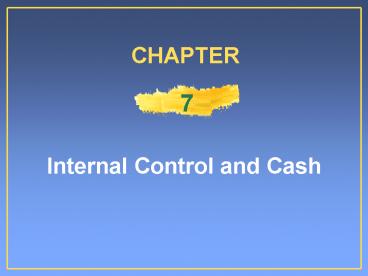Internal Control and Cash - PowerPoint PPT Presentation
1 / 23
Title: Internal Control and Cash
1
Internal Control and Cash
CHAPTER
7
2
Internal Control
- The related methods and measures adopted within a
business to - Optimize the use of resources
- Prevent and detect errors and irregularities
- Safeguard assets
- Maintain reliable control systems
3
Establishment of Responsibility
- Control is most effective when only one person is
responsible for a given task
4
Segregation of Duties
- Related activities should be assigned to
different individuals - Separate record keeping from physical custody of
the asset
5
Documentation
- Provide evidence that transactions and events
occurred - Shipping documents
- Sales invoices
- Documents should be pre-numbered and accounted for
6
Physical Controls
Illustration 7-2
7
Independent Internal Verification
- Comparison, reconciliation, and review of data
prepared by employees - Periodically or on a random basis
- Done by employee who is independent of the
personnel responsible for the information - Discrepancies and exceptions should be reported
to management
8
Limitations of Internal Control
- Cost / benefit
- Human element
- Collusion
- Size of business
9
Cash
- Coins
- Currency
- Cheques
- Money orders
- Money on hand
- Deposits in bank
10
Cash
- Readily convertible into any other asset
- High value in small bulk
- Non-control of owner identification (serial
numbers)
11
Bank
- Minimizes cash that must be kept on hand
- Provides a double record of transactions
- One by the business
- One by the bank
- Safeguards cash by using a bank as a depository
and clearinghouse for cheques received and written
12
Illustration 7-6
- Bank Statement
- Copy of banks records sent to the customer for
periodic review - Shows cheque and other debits deposits, other
credits and the - daily cash balance
13
Terms
- Deposits in transit
- Deposits recorded by the depositor that have not
yet been recorded by the bank - Outstanding cheques
- Cheques written (issued) and recorded by a
company but that have not yet been presented
to/paid by the bank - Adjusted balance
- Reconciled or correct cash balance
14
Terms
- Debit memoranda
- Charges against depositors account e.g. service
charges, RC (returned) / NSF (insufficient funds)
cheques - Credit memoranda
- Amounts that increase depositors account (e.g.,
interest earned)
15
Understanding Debits and Credits
Bank (Your Cash Account is a Liability) Books (Cash is an Asset)
Cheque Debit (decrease) Credit (decrease)
Deposit Credit (increase) Debit (increase)
16
Differences Between Company Balance and Bank
Balance
- Time lags
- The period after a cheque is written and dated
but not yet presented to nor paid by the bank - The period between receipts being recorded by the
company and time receipts being recorded by the
bank - Time lags occur when the bank mails debit or
credit memos to the company - Errors by either party in recording transactions
17
Bank Reconciliation
- This reconciles the balance in the companys bank
account with the cash balance in the general
ledger
18
Reporting Cash
- Cash on hand, cash in banks, cash equivalents,
and petty cash are often combined and reported as
cash - Cash is recorded in both the balance sheet and
the cash flow statement - Cash is the most liquid asset and is listed first
in the current asset section of the balance sheet
19
Cash Equivalents
- Readily convertible to known amount of cash
- So near maturity that market value is relatively
insensitive to changes in interest rates - Examples
- Treasury bills
- Commercial paper
- Money market funds
20
Restricted Cash
- Cash that is not available for general use set
aside for special purposes - If it is not to be used within the next year,
report as noncurrent asset - For example, a bank may require a borrower to
have a compensating balanceminimum cash balance
21
Five Principles of Cash Management
Illustration 7-10
22
Cash Budgeting
- Planning a company's cash needs is a key business
activity - Cash budget shows anticipated cash flows over a
one-to two-year period
23
Cash Budget
- Cash receipts section
- Cash disbursements section
- Financing section































